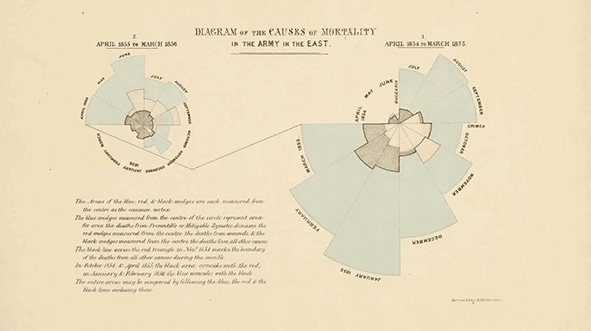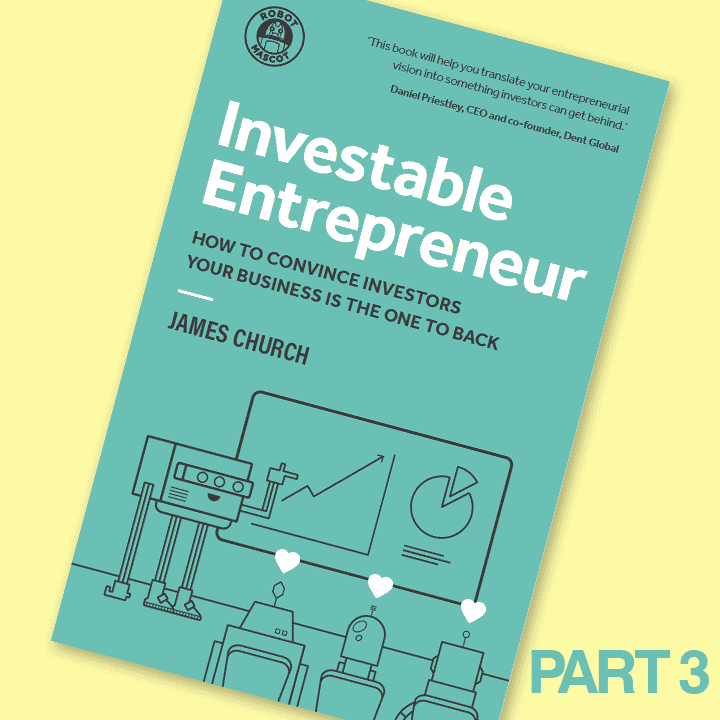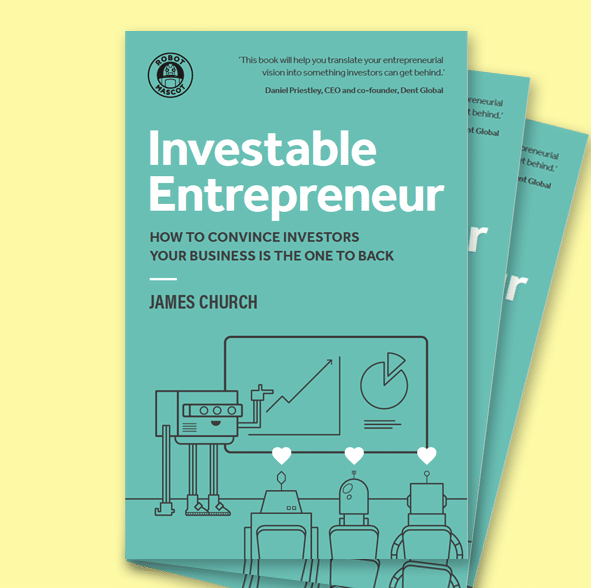Are you an Investable Entrepreneur? Book Interview, Part 3: Next Steps
Standing Out From The Crowd
An interview with James Church on his book for founders seeking investment
We chatted with James Church, author of Investable Entrepreneur, in Part 1 about preparation for the investment process and in Part 2 about putting that preparation into action to secure funding in the ‘real’ world of pitching.
Here in Part 3, we explore the next step in James’ pitching service, the design phase.
Because time is money for startup entrepreneurs, James demonstrates the benefits of working with an agency that has a distinct signature process. We also delve into how intentional design can support your unique selling point and help you stand out.

THE BENEFITS OF A SIGNATURE PROCESS

A signature process gives clients confidence knowing your way of working has been tried and tested. The process has been sharpened and perfected over time, shaped through the funnel of client feedback. This ensures consistency when bringing in results.
MW: You run an agency, Robot Mascot, whose primary services are around pitch decks and pitching. There are other companies out there that also do this, including using artificial intelligence (AI) as a tool to create pitch decks for clients.
Do you have a signature process that’s exclusive to your company? …a special formula that benefits founders that they won’t find with other agencies?

JC: Our signature process is called The Six Principles Of The Perfect Pitch and is the central theme of the book. It’s the process that we follow and have followed for years at Robot Mascot. It’s split into three phases; Prepare, Construct and Create.
The Prepare Phase is the business plan and the financials so that ultimately, the pitch is going to hold up to investor scrutiny.
Then we start thinking about the principles of storytelling. I’ve got a process that is outlined in the book, it’s the five acts of the perfect pitch. It’s essentially a storytelling method that keeps the investor engaged. It speaks to both the head and the heart through the emotion and the logic that we talked about earlier.
Once you get that structure right, it’s then about getting the content clear, concise and articulate. You have to make sure that the content has clarity. Make it as punchy as possible. Get rid of the jargon and the buzzwords. Especially, technical words that don’t translate to an investor outside of your sector or industry.
Then you move into the design phase. This is really your opportunity to make yourself look like the unicorn you could become. You want to look like this business that has huge potential. The first impression is super important. You want an investor to open your attachment on your email and say “Wow, this looks interesting!”. Then you know that from the first couple of slides, they’re absorbing your information in a really positive frame of mind.
Whereas, if it looks a little bit shoddy, their first impression will be, “Ugh, this doesn’t look overly cared for”. It will reflect badly on you. It also means that they’re instantly in a negative frame of mind when reading your pitch and the content. So you’re having to win them over, which is much harder to do. Getting that design right has a massive psychological impact on the investor.
You can be really clever with design by pulling out key bits of information. This helps investors remember key points after you’ve pitched and after they’ve read it. You can use design thinking to make it land and make that content more memorable.
USING DESIGN TO DRAW IN INVESTORS

MW: In the book, you talked about using design in a strategic way. I think for some founders it can be, “we’re just making it look pretty because it’s the content that matters”.
In contrast, you mention how a design thinking approach is very much about using design to give emphasis and reinforce the content. This gives the content structure and context and you are making it stand out. Could you elaborate?
JC: It’s about using design to create a hierarchy so you’re drawn to certain parts of the pitch. You can pull out key pieces of information that you want the investor to remember, using charts, graphs and infographics. This format helps explain complex information like processes or data and make it more memorable.
We can leverage all of those tools to our advantage to land the right message. It gives the investors those key things to hold on to, when considering making investment in your business.
MW: You used some brilliant examples of how design taps into both the emotional aspect, as well as the logical aspect. You mentioned historical figures that point to the power of design.
JC: Florence Nightingale and William Playfair, yeah. The ways in history that we’ve really taken strides forward in the way that we communicate visually. We’ve been communicating visually longer than we’ve been communicating with words.
For example, scribblings on cave walls weren’t just about communicating, “we’ve gone for a hunt”. It turns out that these Palaeolithic cavemen were putting thoughts, feelings and intangible things on these cave walls.
Which is quite mind-boggling. Before we could speak, we were interpreting ideas, concepts, thoughts, feelings and emotions through pictures. We’re really receptive as a species to visual communication. It’s why we can process things thousands of times faster than words. We look at an image and instantly recall what we’ve just seen. But, it would take pages and pages of text to describe that same situation.
William Playfair was the first guy to use design to represent data and graphics. He invented the bar chart and the pie chart. In his day it was a completely innovative way of presenting financial data to boards by using charts and graphs. We take it for granted today, but there’s a lot to learn about using design to represent data.

Florence Nightingale’s data storytelling of The Causes of Mortality in the army in the 1800s
Florence Nightingale was the first person to use design to tap into an emotion, using graphics, illustrations and data. It wasn’t just about presenting statistics but telling a story.
During the Crimea war, she discovered that there were more fatalities. More soldiers dying in the field hospitals than being shot dead and killed by the opposition. She could see, that the people in charge clearly needed to invest more in the hospital and care facilities. She used data statistics and infographics to sway them. This contributed to and influenced the wider war effort.
Power of design

In the above example, we can see the power of design in translating complicated data into meaningful hard-hitting facts.
However, outside of data visualisation, design also is a powerful tool. It is what compels and convinces a customer to choose one brand over another. Those that can tap into the emotions of their customers do it through associations, be it cultural or social.
You can start to influence what people feel through design. Remember your customers buy with emotion and then justify with logic.
PRIORITISING ON A BUDGET

Costs can quickly run away with you, deflating your budget.
MW: Some pitch decks can be a sight for sore eyes but then also having a pitch deck done professionally can be quite costly. It’s a case of the chicken and egg scenario because you’re creating a pitch deck to get investment in the first place.
So in your opinion, when is the right time for a founder to prioritise using a pitch deck agency like yours to help create a stellar presentation?
JC:We’ve got two different ways of working with founders. We have our done-for-you services. This is where our team creates business plans, creates financials, creates pitch decks, and writes all the content.
There is a DIY version of that, called Pitch Ready Sprint, which is done on a cohort basis. This is for them to create the assets themselves. We give them pre-designed templates and guides.
It’s about getting the content and the structure right for the pre-seed founders. They can put it into our template and get it to look good enough to raise that level of funding. They can also go to Upwork and hire someone to do it at a low cost. Additionally, they can bring in a freelancer they know to create something more on-brand.
I think it’s about understanding where your strengths lie. Some people have an eye for good design. They could use Canva or something similar to make a good enough design for that pre-seed round of friends and family.
The design is the thing that changes the mindset. It gets more meetings and more investors interested in what you have to say. To close the deal, you’ll also need the pitch content, the structure, the business case, and the narrative behind it.
When you implement all of the six principles, they add up to create a massive competitive advantage. It puts you ahead of other founders raising money from the same investors.
If you can’t afford to get design done, make sure you’re focusing on all of those things. Do the best you can with what you can afford in all of those areas. That will ultimately be the thing that makes the difference.

Similarly, when it comes to branding, it is unwise to start crafting your brand before you have any clarity. Once you do have this clarity or strategy in place, freelancers and DIY tools like Canva can get you started. But once you’re funded, you should consider hiring professionals to fully utilise the power of design.
CONCLUSION
After reading Investable Entrepreneur and seeing the services of Robot Mascot, we’d say James is well on his way to achieving his “big, hairy, audacious goal” of assisting 100,000 founders in getting funding.
In this final instalment of the series, we looked at James’ tried and tested process. His process helps founders stand out, in a crowded start-up landscape.
From what we’ve learnt from James, here’s a four key steps to connect and fascinate investors with:
The Prepare Step: Have a clear business plan and a strong financial report so the pitch holds up against any investor scrutiny.
The Storytelling Step: Use the principles of storytelling following the five acts of the perfect pitch to keep investors engaged. Make sure you use emotion and logic to speak to the heart and mind of the investor.
The Simplify Step: Clarify and simplify your content to make it as punchy as possible. Get rid of jargon and buzzwords that might not translate well to a non-technical investor.
The Design Step: Create a well-designed first impression to capture the investors’ interest. This ensures they continue to read with a positive frame of mind. Make yourself look like the unicorn you actually are. Use visual hierarchy so they’re drawn to certain parts of the pitch you want them to remember.
Getting that design right has a massive psychological impact on the investor. We’re really receptive as a species to visual communication. Use it to your advantage.
You now have a leg up on your competition. You understand the importance of eliciting an emotional response from investors. You can begin to clarify your message so they listen and stay attentive with an engaging visual pitch.
Investable Entrepreneur is a fantastic resource for getting you started with your pitch and we would highly recommend it.
—
Once you have some Clarity, Muneebah Creative can help you design your brand with the second part of our signature process, Craft. We will help you express your start-up’s personality with a consistent experience that engages your customers with emotion to nurture lasting-relationships. Get in contact.
“Resilience is the flexibility to respond to changing circumstances. It’s what allows brands...
Plus 5 FREE tickets up for grabs!
As well as launching the new brand identity for The Creative Copywriter this...



